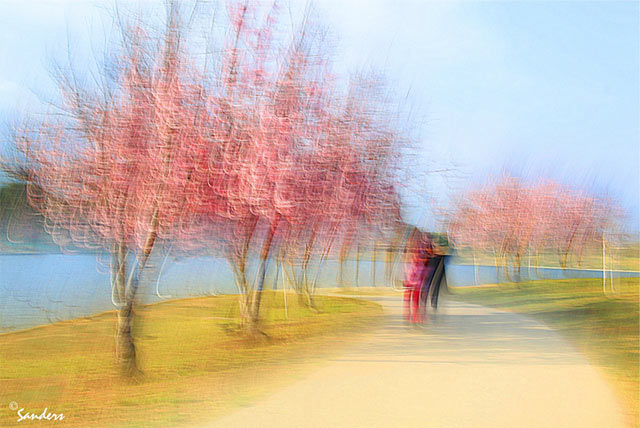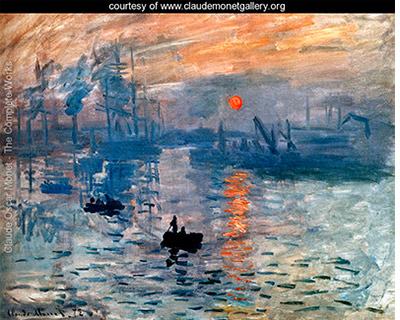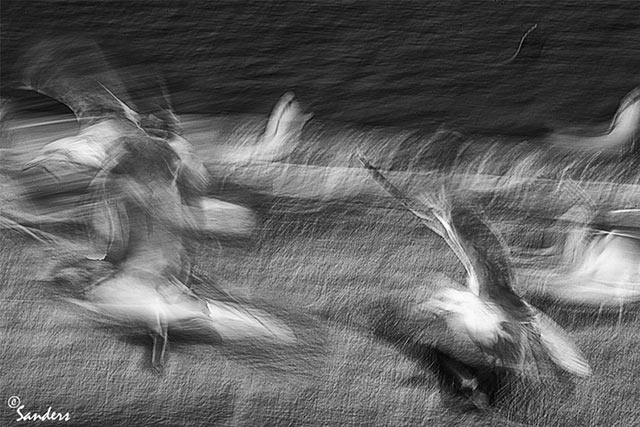
This soft, delicate and highly textured image of couples on a path near Lake Balboa was over sharpened. The benefit is that it helps to produces texture in the image. In the past we were told not to do this as it caused halos and HDR type effects and looked unnatural – break the rules!
Although the art of intentional camera movement has been in existence for decades, each individual photo artist has their own unique approach to creating their impressionistic visions of the world.
I have long admired the feelings, techniques and emotions that are evoked by Monet, Cezanne, Degas, Manet and others of the French Impressionist Period.
When viewing such works as Impression, Sunrise by Monet, something special happens. One cannot just look and continue on.

It requires you the viewer to shift gears after initially absorbing the obvious subject. We then develop an awareness of the nuances of background, color, atmosphere, period, and continually evolving feelings which akin to a veneer, emerge with the additional time spent.
Put more simply, the true enjoyment comes when one engages with the painting.
It is with this premise that I wish to introduce you to a concept I like to term Photo Impressionism.
Why photography and the impressionistic style of art? I have a confession to make. I am a frustrated painter! Maybe you are too.

In all likelihood, you the reader have played by most of the photography rules. You know all the prerequisites for getting the tack sharp, perfectly exposed image. Now, I am asking you to put some of those rules aside and have an adventure with me.
It will not require any new or expensive equipment. It does not ask for you to discover exotic locations or possess involved travel plans. This is about forging a bond with the artist trend setters of the 19th Century and becoming a photo impressionist.
So what is Photo Impressionism?
It is about techniques that are performed in-camera that render your very own impressionistic view of a subject.
The goal for this technique is to illustrate how to be artistic and most importantly, creative. You’ll be asked to explore the recesses of your mind, imagining new potential in the shapes, light and colors about you. The possibilities are limitless…

This technique will teach you not only how to create an impressionistic image, but it will enhance the result for which you search in your normal photography.
This is all about a strong subject, the inclusion of striking visible movement and angles, proper lighting, composition, color, texture and your creative vision of the world around you.
These qualities are the essence of truly beautiful impressionistic art.
If you are a devotee of the art of Impressionism, love to explore the unknown and are looking for new photographic ideas, then I have a project for you that can change your perspective and light your creative fire.
When was the last time that you went on a photographic exercise and were so excited that you couldn’t wait to get home and view the results?
The real voyage of discovery consists not in seeking new
landscapes but in having new eyes. >> Marcel Proust

So, in that vein, get your camera gear and head ready to make your own personal trip as I show you how to use your camera as a digital paintbrush.
Show it to me in a way I have never seen it before. >> My Personal Mantra
How to Get Started
Equipment
All you require is a camera. Everyone has their preferred camera, but let me just say that without question, the very best camera is the one you have with you – my preference being a quality small pocket camera. It’s easy to carry with you most anywhere.
When you come across that paintable scene with great light, you’re ready to go.
No complicated software or image editing program is required. You only need have the minimum basics of image editing, namely sharpening and saturation adjustments.
But you are the digital artists, so if you have the capabilities of utilizing various image editing software programs, have fun with the tools they provide – adjust the levels, curves, blacks, whites, hue and saturation, dodge and burn, add some texture, or….. Enjoy the adventures until you get the photo impressionistic effect you desire.
Create the Photo Impressionistic Images
Camera settings of course will have to be adjusted to adequately fit the ambient light, subject or message the photographer wants to send to the viewer. This is intended only as a guide to get you started.

We need to start with a shutter speed of approximately 1/6th to 1/8th of a second. In order to do that, we need to have a way to properly expose on an average sunny day. This is where a pocket camera, such as the Canon S100 or equivalent, really shines. I set it to its smallest f-stop (f/8) and on manual mode.
I then set it to its lowest ISO of 80 and continuous shoot.The camera has a menu accessible neutral density filter to further increase the exposure time (see if your pocket camera has these setting available, and if not, just use your DSLR and a 0.9 to 1.2 ND filter).
A large LCD screen is a plus, so you can visualize your subject at all times.
Note: If you are using your DSLR camera, be sure to turn off the shake reduction feature. Play with the suggested camera settings above – at 1/6 sec. you may find f/16 works well for the ultimate color. Keep changing your apertures setting until you get the look you like.

Remember how important it was to use a tripod and hold your camera perfectly still? Enter another rule to break! Once you have focused on your subject, you will be shaking the camera as you start to press the shutter button and continue doing so in the rapid fire mode of exposure.
Yes, I said SHAKE IT! Up and down is usually best but side to side or a circular rotation during the long exposure is also permissible.
Vary the degree of shaking from short little up and down or side to side movements to slower movements and everywhere in between – each will give the image and entirely different look.
The duration of exposure will also vary depending upon the amount of zoom and ambient light. Just experiment and enjoy the adventure. THERE IS NO WRONG DECISION TO MAKE – JUST SHAKE, RATTLE AND ROLL!
TIPS: Impressionistic paintings tend to be opaque. Start the rapid exposures with NO shake and then increase the camera motion over a period of a few seconds horizontally, vertically or in a circular motion. See what motion at whatever zoom works the best.
The greater the zoom, the less shake needed. In order to keep your subject from being “transparent” (seeing the surrounding elements through them), you may need to slow down the shake and/or keep it tight.

If the subject of the image is moving, perhaps little or no shaking is required. You are on a learning adventure and will create amazing pieces of art that you did not know were out there or that you were capable of doing.
The results can be totally abstract or possess varying degrees of impressionism. IN THE SPIRIT OF THE OLYMPICS, LET THE GAMES BEGIN!
Make image after image, after image until you have refined your technique and technical expertise.
It involves many exposures as well as time at home culling the photos, but the results will astound you and it just might be difficult to choose your favorites.
From there you will get to expand and express your creativity by sharpening, saturating or…. in your post-production software program. It’s all about your personal visions.
As in Forrest Gump, my momma always said, “Life was like a box of chocolates. You never know what you’re gonna get.” Be sure to look behind you to see if an apparition of Claude Monet is smiling at your images!

Evocative of pilgrims on the Ganges River in Varanasi, oversaturating is another of the issues we were cautioned against. I am asking you to violate this tenet to get the exciting colors and texture that we see in oils and watercolors.
If you enjoyed the intentional camera movement process and my brand of photo impressionism, please add this to your repertoire and let us know how you did.
by Gerald Sanders and Peggy Sanders
Article and photos: © 2014 Sanders. All right reserved.

Inspiring, thank you
Thank you so much for this worthwhile help!
Thank you so much for this. I am a huge fan of impressionism. This certainly looks enjoyable!
Thank you for the wonderful ideas and they astounding pictures !
Thanks for the article . Such photography can be had using rains or water.
Dear , I had the experience of photographing such impressionistic photographs during rains when viewing through the windshield of the car you will find such impressionistic photographs. With best wishes . Tapas Ray , Kolkata
Thanks for the article. During rains we can photograph through the windshields of the car.
Thanks. Rains/water can be used for such photography.
And I thought I invented the term photo impressionism…but I guess I’m a late comer. I love your techniques but mine are almost exactly the opposite of yours. I love to make my images super sharp and super saturated with color…just to the point of making the mind wonder. Well, sometimes I go a bit past that point. But I think I shall try your techniques. Thanks.